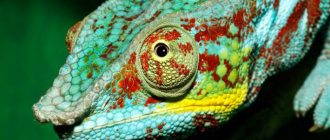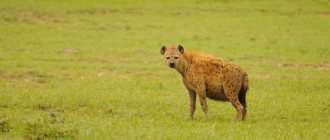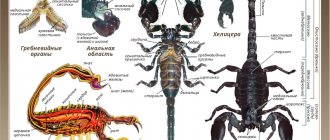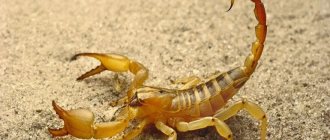WHAT DOES IT EAT?
The common chameleon is the greatest master of camouflage. By changing its color, it completely merges with its surroundings. Hidden among the foliage, the chameleon sits motionless, watching for prey to appear nearby. Having noticed prey, it slowly approaches it and then throws out its long tongue, capturing the victim with its tweezer-like tip. Previously, it was thought that the prey was glued to its sticky tongue, and only filming made it possible to reveal that the chameleon captures prey with its forked tip.
Habitat
Despite the fact that chameleons are not found in Russia, they are quite common reptiles. They live in African deserts, tropics, savannah, southern Europe, southern India, and there are small populations in Hawaii, California and Florida.
These funny animals, like any cold-blooded creatures, prefer warmth. They are most often found in Madagascar, where most of the 200 species known to us live. The most interesting Madagascar species is the smallest chameleon, which is also the smallest vertebrate animal, its length does not exceed one and a half centimeters.
This is often not helped by its color camouflage - their population is declining due to deforestation. Currently, 10 species are threatened with extinction, and 20 may disappear in the near future.
REPRODUCTION
The chameleon leads a solitary lifestyle and only during the mating season does this animal seek company. Each chameleon lives in its own territory and zealously protects it from strangers. The male drives out rivals by adopting a warlike pose - he fills his lungs with air and inflates the skin on his neck.
Chameleons mate in trees. It is timed for mid-to-late summer. The female lays about 20-40 eggs in October-November. She buries them in a deep hole, which she digs with the help of her front legs. The female pushes away the dug ground with her hind legs. After burying the eggs, the female rakes dry leaves and branches on top, forming a dense flooring. Then the female chameleon returns to the crown of the tree, entrusting further care of the offspring to the sun. The young develop in the egg, feeding on its yolk, like chicks. Young chameleons are born after 9 months. They emerge from the shell using a special growth on their head called an egg tooth. Newborn chameleon lizards are miniature copies of their parents. On the ground, babies are in danger of being eaten by predators, so they almost immediately climb trees.
Character and lifestyle
Chameleons spend their entire lives among trees and in their foliage. They descend to the ground in extremely rare cases - during the mating season and when delicacies are noticed on it. The claw-like limb serves as an excellent assistant when moving through trees and greatly hinders the animal on the ground.
This phlegmatic animal is very lazy. The chameleon prefers to lead a sedentary lifestyle. It can sit on one branch for a long time, grasping it with its claw and tail. A possible threat can force the animal to suddenly take off. At such moments, chameleons run beautifully and jump skillfully.
There are many of their enemies in nature. When meeting some birds of prey, large lizards and snakes, the chameleon, sensing danger, swells up, as during a thunderstorm, and takes a defensive position.
Its color also changes dramatically accordingly. The animal begins to make snorting and hissing sounds, and even tries to bite its enemy, which is not very successful due to its weak teeth.
Recently, people like to have exotic animals. The chameleon, as a pet, is one of them. This beautiful creature must be kept in a terrarium. This doesn't require much hassle. The main thing is to initially create appropriate conditions for the pet and periodically clean its home.
SELF-DEFENSE
Camouflage coloring not only helps the chameleon remain invisible while hunting, but is also an excellent defense against enemies. The change in color of chameleons is associated with the structural features of their integument. The outer layer of the skin of these animals contains chromatophores - cells with grains of dark brown, reddish and yellow pigment. When the processes of the chromatophores contract, the grains gather in the center of the cells, and the skin of the chameleon becomes whitish or yellow. When dark pigment is concentrated in the fibrous layer of the skin, it turns black. The appearance of other shades is caused by the combination of pigments of both layers. And green tones arise as a result of the refraction of rays in the surface layer, which contains guanine crystals that refract light. The reptile can also change the color of individual parts of its body.
New in blogs
Although chameleons can be found in many parts of the world with warm climates, almost half of the two hundred known species are found in Madagascar.
Most chameleons lay eggs, but some give birth to babies in soft, translucent shells that resemble a cocoon.
The word "chameleon" comes from the Greek "chamaeleón", which literally means "ground lion".
Parson's chameleon is the largest known species. Adults reach 70 cm in length.
The world's smallest chameleon is the leaf chameleon, reaching a length of about 1.6 cm and easily fitting on a match head. It is one of the smallest known vertebrates.
The chameleon has excellent vision with a 360-degree field of view and can look in two directions at the same time.
The language of chameleons is also quite remarkable. It is almost twice the length of the animal's body and is capable of shooting at lightning speed towards prey.
Most often, chameleons feed on insects, but some large species are not averse to eating a lizard or even a bird.
Chameleons are loners. Most of the time the female does not need the male's presence. The male approaches for mating in those rare moments when the female allows touching.
Chameleons do not care for their offspring and the young are left to their own devices immediately after birth.
Like snakes, chameleons do not have an outer or middle ear, so they have neither pinnae nor eardrums. However, they are not deaf. They can hear sounds with frequencies ranging from 200 to 600 Hz.
Contrary to popular belief, chameleons do not change color for camouflage, but to control their body temperature and communicate with other individuals. This is how he expresses his emotions.
The head of the veiled chameleon, which lives in the arid mountainous regions of Yemen and Saudi Arabia, is decorated with a high, developed crest. This comb serves the animal to collect water - drops of moisture roll down its grooves directly into the chameleon’s mouth.
In the wild, a chameleon's lifespan is usually 2-3 years, but in captivity it can reach 10 years.
The chameleon's tongue shoots out at extraordinary speed, reaching its prey in 0.07 seconds.
Unfortunately, the ability to mimicry does not save chameleons from deforestation, which is their main habitat. Currently, about 9 species are on the verge of extinction, and another 37 species are threatened.
Unlike many other lizards, chameleons cannot shed and regrow their tail.
In addition to the visible spectrum, chameleons also see in ultraviolet light. When exposed to ultraviolet rays, they demonstrate an increase in activity and sociability.
The incubation period for chameleon eggs usually lasts several months, but Parson's chameleon eggs take as long as two years.
Chameleons have a strange gait - they sway from side to side while walking. Some researchers believe that in this way they imitate the swaying of leaves in the wind, but this theory has not yet received scientific support.
FEATURES OF THE DEVICE
The name "chameleon" comes from the name of a mythical creature that changes its appearance. However, the ability to quickly change color depending on the color of surrounding objects is not the only characteristic feature of the common chameleon. The unusual structure of the visual organs also deserves attention. The eyes of a chameleon are large and round, they are surrounded by a continuous ring eyelid, in the center of which there is a small hole for the pupil. A chameleon's eyes move completely independently of each other. The eyes rotate freely 180° horizontally and 90° vertically. The body of chameleons is strongly compressed from the sides. The head is helmet-shaped, decorated with ridges and tubercles. The legs are long. The fingers end in sharp claws. The common chameleon uses its prehensile tail as a fifth limb.
Types of lizards
In total, this population has 11 genera, which, in turn, are divided into 193 species. Among them there are more common ones, and there are species of which there are few representatives left on the planet.
The largest populations include the following species:
- Common chameleon;
- Panther chameleon;
- Comb chameleon;
- Yemeni species;
- Jackson's chameleon;
- Desert Chameleon;
- Calumma tarzan;
- Furcifer labordi from a species of Madagascan chameleon;
- the smallest Brookesia micra;
- Giant chameleon.
Each species has characteristic differences in color and size.
GENERAL PROVISIONS. DESCRIPTION
It uses its tongue to obtain food for itself - having noticed the victim, it gets into it with its sticky tongue and instantly sucks it into its mouth.
Chameleons are a special group of lizard-like animals that can be found in almost all forests of Africa. They protect themselves from enemies by changing their body color, merging with their environment. The chameleon turns dark when irritated and pale when frightened. A chameleon's eyes rotate as if on hinges, and its tongue can be longer than its entire body. The body size of a chameleon is up to 30 cm. There are from 7 to 38 small chameleons in a litter.
Nutrition
The chameleon's diet consists of grasshoppers, crickets, butterflies, beetles, small lizards and snakes. Chameleons, which are larger in size, prefer to hunt rodents, birds and small animals. Sometimes the animal’s menu is diluted with tree fruits and leaves.
Even when very hungry, he does not hunt insects that can sting him. The chameleon has never eaten wasps or bees. He loves tangerines and oranges very much.
Cherries, grapes, persimmons and kiwis, vegetables and herbs are also his favorite delicacies. This makes caring for them at home easier for those who decide to buy a chameleon.
FEATURES OF THE CHAMELEON'S DEVICE
Hunting method:
The chameleon usually sits motionless on a branch, and only its eyes carefully examine everything around in search of insects. Having noticed the prey and continuing to follow it, the chameleon begins to slowly move towards it until the distance to the prey reaches the length of its tongue, and then with lightning speed it throws out its tongue and grabs the insect with its forked tip, like tweezers.
Behavior:
a chameleon sits motionless on a thin branch without losing its balance. It holds itself on all four legs with claw-like feet and hands, and wraps its long, prehensile tail around a branch.
Language:
length up to 30 cm, ends with a sticky, forked end.
— Habitat of the common chameleon
WHERE IT LIVES
The common chameleon lives in North Africa, southern Spain, the islands of the Mediterranean Sea, as well as in southern Turkey, Syria and Arabia. It is also found in India and Sri Lanka.
PROTECTION AND PRESERVATION
The common chameleon is not in danger of extinction. A decline in lizard numbers could cause cold summers.
Where do they live?
The range of modern chameleon species is limited to the territory of Africa and the southern regions of the Indian and Arabian Peninsulas. Some varieties are found in the south of Western Europe. Most of the known species of chameleons live on the island of Madagascar. Some researchers believe that this is where the historical homeland of arboreal reptiles is located.
Where live
For most species, the natural habitat is the dense branches of trees and shrubs of tropical forests or savannas.
Pygmy chameleons live on the forest floor, hiding in grass, leaf litter and under low-lying branches. There are several terrestrial species in the family that live in steppes and desert regions where there is little or no vegetation. Natural shelters or burrows dug by rodents or other animals provide protection from scorching heat and predators for reptiles.
TRITON











